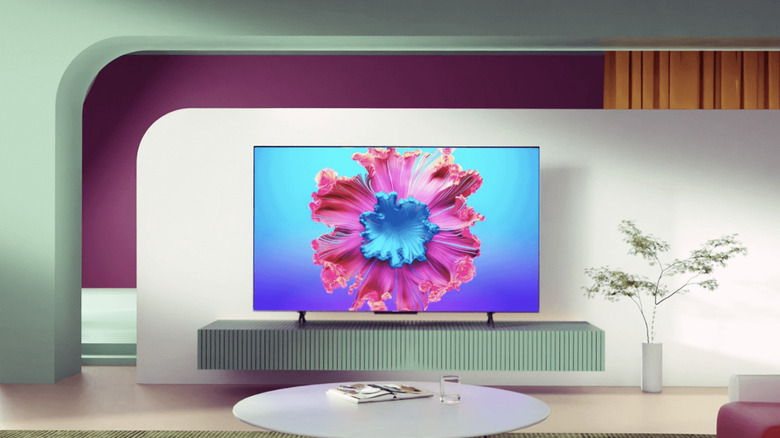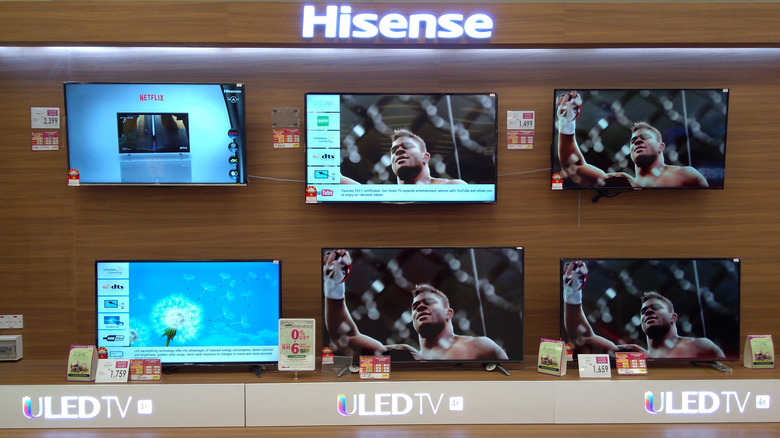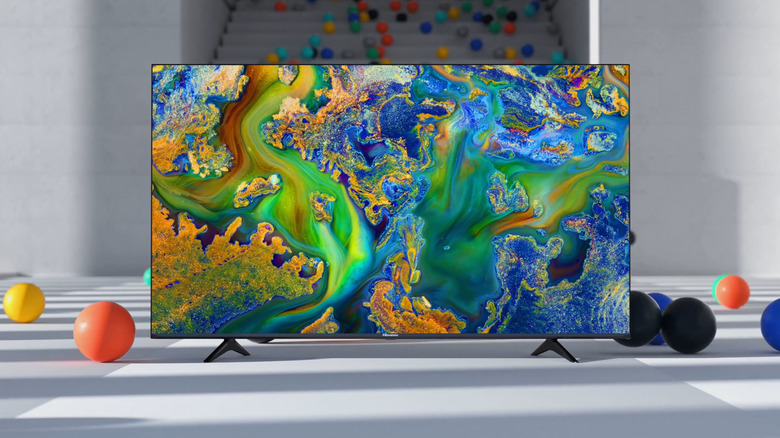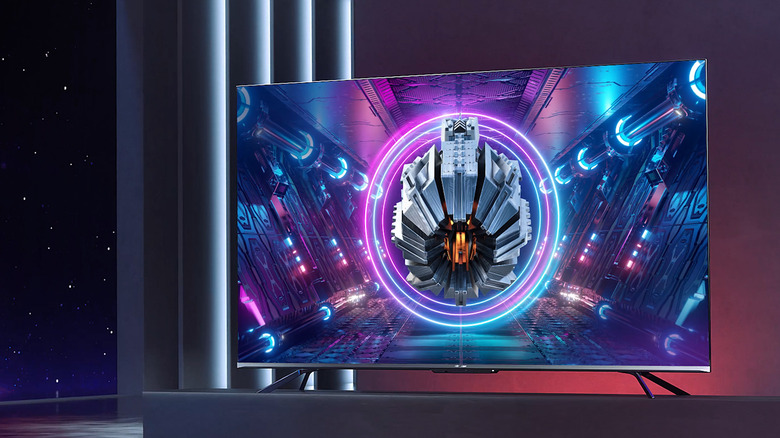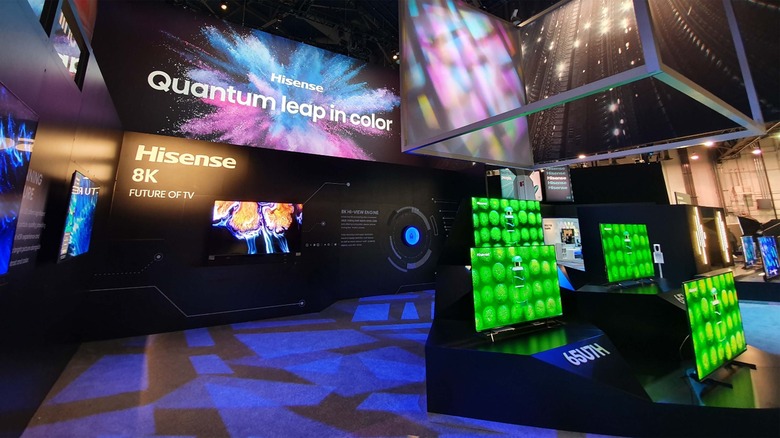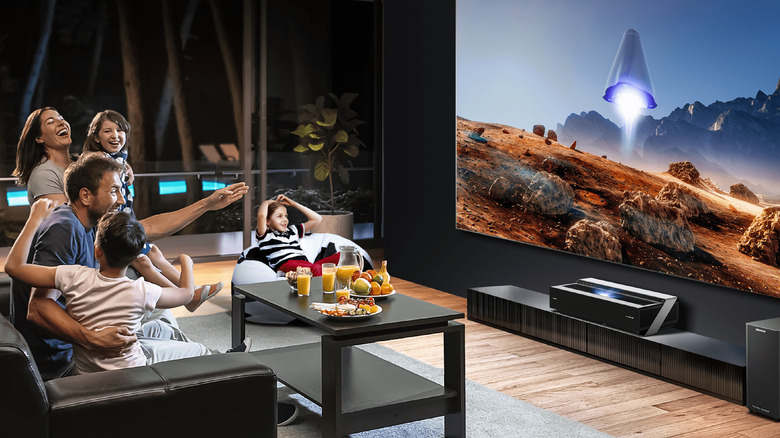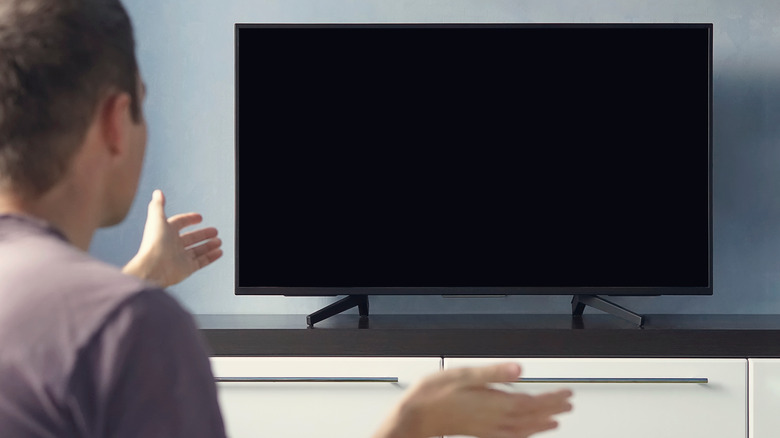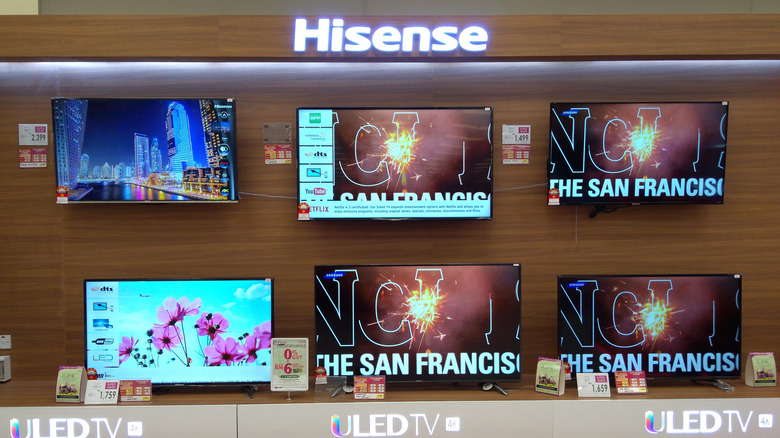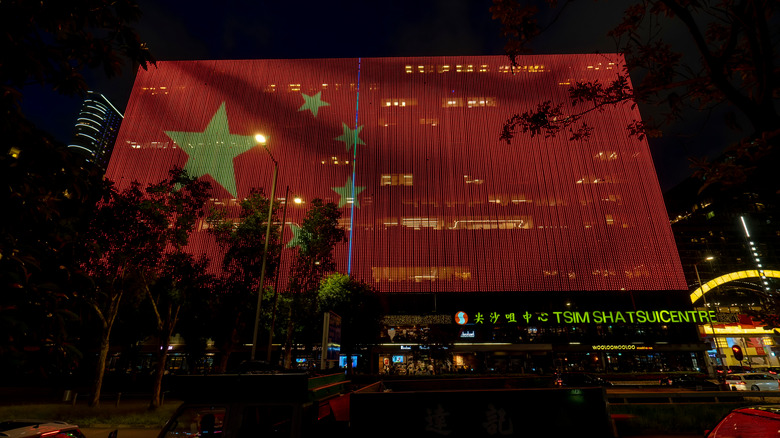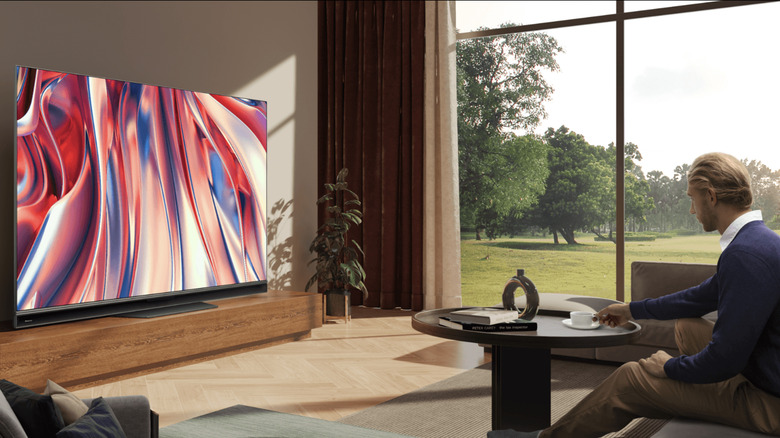The 5 Best And 5 Worst Things About Hisense TVs
We may receive a commission on purchases made from links.
As Hisense grows as a television brand, many people have noticed that its prices pale in comparison to TVs with similar technical specs from Samsung and LG. That leads to inevitable speculation about whether the Hisense TVs are of equal quality and dependability. In short, they are for the most part, with some caveats.
While Hisense originated in 1969 in Qingdao, China, Hisense USA was founded in the 21st century, so many people stateside are not very familiar with the name and are understandably wary of it. However, the fact is that Hisense licensed the Sharp name in 2015 and manufactured Sharp TVs from 2015 to 2019. Hisense also bought the Toshiba TV business in 2017, so Hisense has been making TVs with household names for several years, unbeknownst to many potential customers.
Here, we look into the most important positive and negative aspects of Hisense TVs, so you can decide if that tempting price tag is actually worth it in the end.
Best: Great value for the price
Looking at the four major lines of Hisense 4K TVs, the U6, U7, U8, and U9, they compare very favorably in price against the equivalent options from leading brands like Sony, LG, and Samsung. For example, when comparing the current prices at Best Buy for those four brands of TVs, the 55-inch Hisense U6G costs $499, while the comparable the LG 55-inch NanoCell 80 Series costs $679; Samsung 55-inch Q60A costs $699; and the Sony 55-inch X85J costs $849.
The top-of-the-line Hisense U9 series gets closer to the other brands' pricing, but the 75-inch Hisense U9DG, at $1,999, is still lower than the comparable TVs from LG ($2,199), Sony ($2,499), and Samsung ($2,699).
Yet despite the value pricing, expert reviews still call Hisense a dependable, high-tech, and high-quality brand and mention the Hisense TVs' high picture quality, including satisfying image sharpness, black levels, and rich color.
Best: High-tech features in mid-range TVs
TV shopping can cause a frustrating mishmash of details in your head as you try to keep straight which models from which brands have all the right tech features you want. Just because you've heard about cool technologies like Dolby Atmos sound or HDR10+ picture, that doesn't mean that every new TV available will support them.
Fortunately, you can tell from the Hisense TVs available right now (as linked above) that they are more likely than not to incorporate more new technology standards than other TVs in a similar price range. Beginning with the brand's mid-range 4K line, the U7G series, you'll get Dolby Atmos and IMAX Enhanced audio (additional surround-sound speakers required), a fast refresh rate of 120 Hz, and a full complement of HDR technologies (Dolby Vision/HDR10/HDR10+/HLG). By comparison, Samsung only this year at CES 2022 announced Dolby Atmos support for new TV models coming out later this year, and they still will not include the Dolby Vision HDR format. Also, those Samsung TVs are likely to cost significantly more than the comparable Hisense units.
Hisesnse is also a bit ahead of the game in making short-throw 4K HDR laser projectors with 100-inch or larger screens, which it calls Laser TVs — a path that brands like LG are also traveling.
Best: A focus on gaming
Gamers—especially those who prefer to use the latest consoles on large TVs rather than computer monitors—should appreciate that Hisense has added many next-gen technologies aimed at gaming to its mid-range U7G series, as well as its higher-priced U8G series.
Hisense's U8G series and U7G series 4K ULED TVs from 2021 both added high-bandwidth (up to 48Gbps) HDMI 2.1 ports. The HDMI 2.1 spec allows other key gaming technologies that these TVs support: 120 Hz refresh rates—also called High Frame Rate (HFR)—for presenting fast, fluid motion smoothly, Dolby Vision HDR, Variable Refresh Rate (VRR), and Auto Low-Latency Mode (ALLM). All of the above make these TVs especially suited to next-generation gaming consoles like the Sony PS5 and Xbox Series X, because the TVs will automatically detect a gaming signal and reduce the input lag of your game console button presses and match the frame rate of the game console to the TV, making gameplay as seamless as it can be.
Best: They're only getting better
While Hisense TVs have a lot to offer now, the company's TV announcements from CES 2022 suggest that the best days are yet to come. Hisense has introduced upgrades to all four of its major series of LED TVs covering different price tiers: the U6H, U7H, U8H, and U9H. To be released later in 2022 (no earlier than June), all four series adopt the Google TV operating system, which upgrades the older Android TV with greater focus on personalized content and profiles, mobile app features, and live broadcasts.
The mid-priced sweet spot for many gamers, the Quantum 4K ULED U7H, which will be available in display sizes of 55 to 85 inches, keeps Game Mode Pro and all the other gaming-focused features from 2021's U7G mentioned above, but also adds an ATSC 3.0 tuner for receiving free over-the-air 4K television with advanced audio formats.
Meanwhile, if you have the budget for either of Hisense's step-up series, the new U8H series and 75-inch U9H will both include Mini-LED technology, which is a next-generation display technology in competition with OLED. Mini-LED is said to offer advantages in display brightness and HDR performance. The U9H best-of-everything flagship Hisense TV will carry a substantial MSRP price tag of $3,199, but none of the 55-inch, 65-inch, or 75-inch U8H models will exceed $1,500.
Best: A vetted record of business practices
Hisense USA currently has an A+ rating with the Better Business Bureau, which, among other things, reflects the BBB's assessment of how Hisense USA conducts good-faith customer service to resolve customer complaints and troubleshooting problems. In February 2022, the BBB had registered 409 customer complaints over the last three years, of which 198 had been resolved in the last year. About 60% of the complaints fell into the category of "Problem with a Product or Service," and around 35% of them regarded the "Guarantee/Warranty."
The BBB ratings for businesses take into account several other factors beside customer complaints, such as the business's transparency when it comes to information on its products and services offered. How the business exercises truth in advertising also factors into its BBB rating. Many BBB-rated businesses add badges to websites and icons to store windows indicating the brand's affiliation.
Worst: A reputation for unreliability
In 2019, Consumer Reports removed Hisense from its recommended list for receiving a "Fair" rating in both predicted reliability and owner satisfaction from a survey of nearly 100,000 TV owners. The survey suggests that 20 percent of Hisense TVs have a problem within five years of purchase, which is almost twice as much as the 11 percent of Sony TVs that had a problem within five years. As such, Sony received a "Very Good" reliability rating (two steps higher on the rating scale than "Fair"). Consumer Reports will not recommend any brand designated with a "Poor" or "Fair" rating for predicted reliability.
Keep in mind that these survey results were for entire brands, not for individual TV models that the brand makes. The lower reliability rating does not mean that each TV set will experience problems faster than other brands, but rather that problems occur with certain TV sets at a higher rate than other brands. From the same survey results, Vizio also received a Fair rating for predicted reliability and lost its Consumer Reports recommendation.
To provide some context to what TV owners are used to when it comes to product life, the survey results discovered that 87% of the people who bought their TV in 2010 were still using the same set roughly eight or more years later.
Worst: Smart TVs that aren't so bright
We don't always watch TV in a darkened room, so a set's brightness is important. Greater brightness also helps to deliver better HDR performance. Hisense TVs, particularly in the budget priced U6G series and some of the sub-4K models, don't exhibit best-in-class brightness. Reviewers, as well as raw specs, point to a less-bright experience from Hisense TV displays when compared to Samsung and LG TVs in the same price tier. For example, the Hisense 55U6G has a brightness rating of 250 cd/m2 (candela per square meter), while the competing LG 55NANO90UPA offers 390 cd/m2 brightness, and the Samsung QN55Q80A has 500 cd/m2.
Display brightness then may be an area where Hisense saves a little bit of cost in the production process to keep retail prices down. Processing power may be another area, or at least it may have been. Although Hisense has now stopped making OLED TVs, the Hisense H55OB8UK was the cheapest OLED TV on the market in its time. It's been suggested that it did not have the processing power to keep the picture consistent at all times.
Worst: Some inconsistency with the displays
Some reviewers have found that the viewing angles of the Hisense ULED TVs, which are the company's competitor to LG NanoCell and Samsung QLED TVs, are narrower than the regular LED Hisense TVs, as well as narrower than their competitors' TVs. Some other display inconsistencies have been found, occasionally including red motion tracers and some color inaccuracies.
All TVs can — and often do — experience problems with their screens at one point or another, but some other display issues that have come up regularly with Hisense TVs include the display freezing up and screen flicker that may be caused by unclean power, interference from other nearby electronics, or from a variety of the TV's Energy Saving settings. One of the most frustrating aspects of this for the consumer is the fact that many users aren't able to fix this issue on their own in an immediate fashion.
Worst: Privacy concerns from data collection and back-door hacking threat
Like most smart TVs, Hisense Internet-connected smart TVs are vulnerable to malware and if they are insecure enough, could be hacked as a back-door to your home wireless network.
Fortunately, most smart TVs have read-only operating systems, which mitigates the damage that a virus can do. And many Hisense TVs use the Android TV operating system or are soon to use the Google TV operating system, which if they don't already contain anti-virus software, can download anti-virus apps from the Google Play Store. But a hacker could still change your channels, blast the volume, and more, which at best would be a very annoying violation.
If a smart TV has integrated microphones or cameras, hackers could spy on you through audio and video. Hisense collects data in order to use many of the smart TV services. Turning off all data collection causes loss of functionality you likely bought the TV for, such as internet connectivity for streaming content or TV control over mobile apps.
Hisense does collect a substantial amount of information related to your TV setup and use, and its list of exceptions for disclosing that information to third parties could amount to almost any reason it deems acceptable. And it's been reported that Hisense derives income from streaming services based on your information and viewing habits, which they use to either target advertising or their content to you.
Worst: A state-owned enterprise (SOE)
Hisense is one of the many state-owned enterprises in China. Some economists believe that SOEs are inherently more likely to be inefficient and thus more susceptible to bankruptcy.
Beyond that, however, there's the question of whether or not you want to purchase your internet-connected smart TV from a company owned by a one-political-party authoritarian state that has a poor record on human rights and a 2021 Human Freedom Index score well below average. Human Rights Watch notes that the Chinese Communist Party has ramped up its domestic repression of citizens since 2013 and calls its persecution of ethnic minorities such as Turkic Muslims since 2017 "crimes against humanity."
The Human Freedom Index, co-published by several foundations such as the Cato Institute, ranks countries on Human Freedom, Personal Freedom, and Economic Freedom based on 12 categories, including rule of law, movement, religion, expression, and property rights. In the latest index, China tied Chad for the ranking of 150 out of 165 countries, with a 5.57 score for Human Freedom. The average score for all countries was 7.13, and Switzerland scored the highest with 9.11.
Proceed to checkout, but proceed with caution
For the most part, Hisense TVs can provide you with the latest technologies and very good performance for the price when compared to the big-name brands such as Samsung, LG, and Sony. Performance varies by the model series within the Hisense overall TV line, but generally, Hisense TVs are praised for sharp picture quality, including rich colors and deep black levels, and their gaming features. The downside of certain Hisense TVs has been their comparatively lower brightness levels display inconsistencies that may be due to lower processing power. However, the Hisense TVs are continually improving, and pundits anticipate great things from the new U6H, U7H, U8H, and U9H TVs arriving beginning in the summer of 2022.
There are some concerns that on average Hisense TVs experience problems after purchase sooner than those other brands, as well as the security and privacy questions regarding data-collection by a Chinese SOE. However, if the value is worth those trade-offs to you, Hisense TVs present very attractive options that seem to be getting only better with time.
